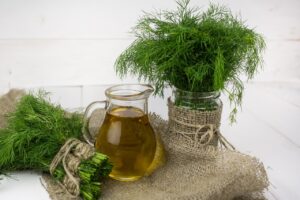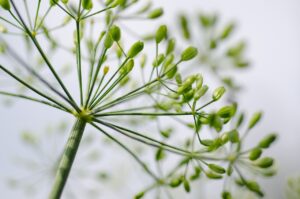Dill
Overview
Dill is an herb loved for its culinary versatility and ease of growing. Recognizable by its feathery green leaves and distinct aroma, dill offers multiple kitchen uses, from pickling to flavoring dishes. A favorite for gardeners, it not only enhances recipes but also aids in garden management by deterring pests.

Characteristics
Known for its aromatic foliage, culinary versatility, use in pickling, and pest-deterring properties in gardens.
Region
Dill is commonly grown in Europe and Asia and adapts well to many regions with a temperate climate.
Natural Habitat
Dill is typically found in fields and cultivated grounds.
Cultivation
Prefers full sun to partial shade, regular watering, and well-drained, loose loamy soil with a pH of 5.5 to 6.5.
Uses and Benefits
Dill, bursting with both flavor and versatility, finds its way into a myriad of dishes. Its delicate, feathery leaves add a unique flavor to pickling brines, elevate the taste of soups, and complement dressings and potato recipes2. Beyond the kitchen, dill’s presence is a boon in the garden; it’s known to deter certain pests, making it a favorite among companion plants2.
Moreover, adding a touch of dill to fresh-cut flower arrangements can create a visually stunning and aromatic experience3. Whether in the garden for its practical benefits or used in the kitchen for its culinary charm, dill is truly an herb of many talents.

Cultivation Tips
For those with a green thumb or just starting their gardening journey, dill is a delight to grow. To ensure your dill thrives, pick a spot with full sun; this herb loves the warmth but appreciates a touch of afternoon shade in scorching climates5. Plant dill seeds directly where they are to grow, as they form a deep taproot and don’t take kindly to being moved1. Sow seeds just ⅛ to ¼ inch deep in loose, loamy soil with proper drainage, and aim for a soil pH between 5.5 and 6.51 5.
Dill’s journey from seed to spice is relatively quick – it’s generally ready to bloom about eight weeks after planting4. Remember, once dill flowers, it shifts its energy from leaf to seed production—so enjoy the fragrant foliage before it transitions to its next phase. Harvest the seeds as they mature and turn a brownish hue4. With these tips, you can look forward to a successful dill harvest that adds a fresh dimension to your culinary experiences!
Seasonal Considerations
When considering dill in your garden, the season plays a pivotal role in the planting process. As a plant that relishes the sun, spring is an opportune time to begin sowing dill directly into your garden, when the soil has started to warm up. It’s best to time your planting after the danger of frost has passed, as dill seedlings are sensitive to cold temperatures.
Keep in mind though, dill grows quite swiftly, so successive plantings every few weeks until midsummer can ensure a continuous supply of its fragrant leaves.1 5 However, once the heat of high summer kicks in, dill will bolt—sending up flower stalks and subsequently producing seeds. This is a natural progression and denotes the end of the leaf harvesting period. To keep the dill coming, simply save some seeds to plant for a fall crop, capitalizing on cooler temperatures for a second round of leaf production.

Issues and Troubleshooting
Dill can be delightfully easy to grow, but it’s not without its quirks. One common hiccup is its sensitivity to transplanting, thanks to a long, thick taproot which prefers to go undisturbed1. It’s best to sow dill seeds directly where they’ll flourish without the stress of moving.
Other issues might crop up, such as inadequate sunlight, especially in cooler climates where dill craves full exposure5. And while dill isn’t too fussy about soil, it does need a spot that drains well and is moderately fertile5. Keeping an eye out for these growing conditions can lead to a bountiful dill harvest, ready to add its flavor to your culinary creations.
History and Folklore
Steeped in history and shrouded in the mystique of folklore, dill (*Anethum graveolens*) carries a legacy as rich as its flavor. Ancient civilizations valued dill for its medicinal properties, and in medieval times, it was commonly used as a magic charm to protect against witchcraft. Its name is thought to derive from the Old Norse word “dilla,” meaning to lull, reflecting its traditional use as a remedy to soothe and lull the restless to sleep. In Roman times, dill was a symbol of vitality, while to the Greeks, it signified wealth. This aromatic herb danced through the pages of history not just within the kitchen, but also as a revered plant in cultural lore, where it was intertwined with protection, healing, and prosperity.
References
1. How to Plant, Grow, Care For, and Harvest Dill – Epic Gardening, https://www.epicgardening.com/growing-dill/
2. Dill: Planting, Growing, and Harvesting Dill Weed in the Garden | The …, https://www.almanac.com/plant/dill
3. Dill Plants: How To Grow, Harvest & Use Them – Little Yellow Wheelbarrow, https://www.littleyellowwheelbarrow.com/dill-plants/
4. How to Grow and Care for Dill – The Spruce, https://www.thespruce.com/dill-tips-for-growing-and-using-1402606
5. Growing Dill: The Complete Guide to Plant, Grow and Harvest Dill, https://morningchores.com/growing-dill/
Image Credit: luiza_83
Image Credit: jyliagorbacheva
Image Credit: Kathas_Fotos
Nicolas Duval
Nicolas is a passionate advocate for nature and the art of wildcrafting. His dedication shines through in Wildcraftia, a website he meticulously crafted to serve as a haven for nature enthusiasts worldwide. Driven by a deep appreciation for nature’s connection to humanity, Nicolas embarked on his journey in 2011 with SmokableHerbs, a platform showcasing his love for nature’s bounty. Building upon this foundation, he established Smokably, a thriving online store offering premium herbs and blends to a global audience.
